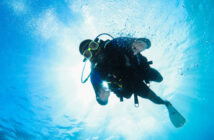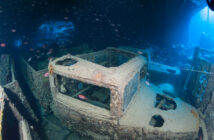Many city dwellers think of Ontario’s cottage country northeast of Toronto as rather remote. But in 1956, it was much more so. The area was sparsely populated and roads were smaller and fewer in number.
The November day was crisp and cold as Harry Kendig pushed the throttle of his Republic RC3 Seabee amphibian forward. He was taking off for Cleveland, Ohio from Crystal Lake northeast of Bobcaygeon after a hunting trip in the Kinmount area. There was not much time to waste, as the lake was beginning to freeze over. The Lycoming six-cylinder, air-cooled engine with its prop facing rearward on top of the wing began to roar as the small plane moved across the lake.
Kendig looked forward to a pleasant flight as he pulled back on the stick and the plane broke free of the water. The ceiling and visibility were unlimited, with calm winter air promising a smooth journey for the flight back home. But the little Seabee would not be arriving in Cleveland today, or ever. As the trees on the eastern shore loomed closer, the aircraft began to shudder from the vibration of the engine as it began to lose power. The aircraft was losing altitude and at 200 feet. Kendig had a quick decision to make. In flight school pilots are taught not to attempt to turn back to the runway on losing power, but to land straight ahead. But this was the bush and to attempt to land straight ahead would put him into the trees. Harry attempted the 180-degree turn, hoping to land safely on the water. He almost made it.
“Where do you go when you go diving?” asked my friend in the spring of 2013. The club I belong to, Scarborough Underwater Club Inc., plans dive trips in Ontario and the United States. Dive sites such as Tobermory and the St Lawrence River are two good options. I’m also a member of the Canadian Harvard Aircraft Association Dive Recovery Team. We look for planes from the Second World War that have gone down in the water here in Canada.
There’s a plane in Crystal Lake near my family’s cottage. It could seen from a boat, but that was 25 years ago. There are two Crystal lakes in Ontario, so I began to look through old newspaper articles to find stories on RCAF aircraft crashing into a lake in the Fenelon Falls area, but the closest was an Avro Anson that crashed into a hillside at Kinmount in 1943.
The Anson, a twin-engine aircraft used in the British Commonwealth Air Training Plan to train pilots and navigators, had stalled and crashed into a hill, a complete write-off killing all aboard. This was not uncommon during the war when Canada trained thousands of pilots from all over the British Commonwealth and patriots from the occupied nations of Europe, as well as Americans who had volunteered during the two year period before the U.S. joined the conflict.
A search permit from the Ontario Ministry of Culture and Recreation is required to even look for a lost Canadian military aircraft or ship, never mind dive on it. This is to protect heritage sites and war graves from plundering souvenir hunters. However, a diligent check of government crash reports from the Canadian military and the Canadian Harvard Aircraft Association dive recovery team, revealed that there had been no reports of RCAF aircraft going down anywhere near the search area. I called the marina operator at Crystal Lake, a fellow named Ron, and he confirmed the story of a plane going down in the lake years before. He knew a diver who had seen it and being a diver himself he wanted to dive to the wreck and had obtained the approximate location.
I then called my neighbour Gail Overton, an experienced Dive Master and asked if she would like to help me search for a lost aircraft. It was at least a two-hour drive to the site and I had no idea what the visibility and water temperature would be. Gail replied “I’m in.” We headed out to cottage country to meet Ron at the marina, where we loaded the gear onto his pontoon boat for the short trip to the search area. “I was told it’s about 30 feet from shore, directly opposite a burnt stump,” said Ron.
When we entered the water, visibility was about three feet. I saw nothing but silt and rocks. We lost sight of each other and quickly surfaced. As no one had yet spotted anything we decided to descend on the other side of the boat, closer to shore. Soon after descending to 23 feet, I met Ron and we discovered a ribbed piece of material still holding some blue paint and resting on the bottom, recognizable as part of an aircraft rudder. Ron began to move on and I was only able to make out the faintest outlines of Ron and Gail, about 12 feet away. But looking down I saw what at first appeared to be a log. On closer inspection I noticed three holes about four inches in diameter, equally spaced along the length of this object, which was the same colour as the surrounding twigs and rocks, everything being covered in a yellowish green silt.
I brushed off some silt around the nearest hole, (creating a dust cloud that looked like an undersea volcano. I noticed that the material appeared to be aluminum).
No longer seeing my fellow divers, I surfaced and about 30 seconds later Gail and Ron broke the surface. I said that I had found what looked like part of a wing or fuselage, (it was partially buried in the mud) and Gail replied that they had also seen the wreckage and she had shot video with the new Go-Pro that she had brought to check out. Ron thought the holes looked like inspection holes. When I asked how he knew, he replied that he had worked for de Havilland Canada at Downsview, before taking over the Crystal Lake Marina.
We had apparently found part of an aircraft wreck, but what kind? Perhaps another expedition later to try to find more wreckage showing a registration number, or perhaps we would even manage to locate the data plate. I sent Gail’s one minute video of the wreckage to some ex-military members of the Canadian Air and Space Museum, as well as the Canadian Harvard Aircraft Association. Within 24 hours I had a reply from Shane Clayton of the Canadian Harvard Aircraft Dive Recovery Team. H wrote “I think what you may have found could be a Republic Seabee, that crashed in 1956.” He also included a drawing and a link to a Library and Archives Canada title regarding a crash of an aircraft of that type in November of that year.
![]() As Harry Kendig’s plane touched down on the lake and skimmed across the water it had begun to settle and slow, when with a loud thump and cracking sounds the aircraft suddenly slewed to the left. The pontoon on the port-side wing had struck a rock under the water and the plane came to a stop on a rock shoal close to shore. Kendig managed to exit the now half-submerged aircraft, removing his logbook and a couple of rifles. He was brought to land in a small boat by Gordon Craig, who had witnessed the accident and at whose farm Kendig had been staying. Kendig reported the accident to Canadian Customs at Malton Ontario (now Pearson International Airport) where he had reported in on his way to Crystal Lake.
As Harry Kendig’s plane touched down on the lake and skimmed across the water it had begun to settle and slow, when with a loud thump and cracking sounds the aircraft suddenly slewed to the left. The pontoon on the port-side wing had struck a rock under the water and the plane came to a stop on a rock shoal close to shore. Kendig managed to exit the now half-submerged aircraft, removing his logbook and a couple of rifles. He was brought to land in a small boat by Gordon Craig, who had witnessed the accident and at whose farm Kendig had been staying. Kendig reported the accident to Canadian Customs at Malton Ontario (now Pearson International Airport) where he had reported in on his way to Crystal Lake.
The Customs office in Peterborough contacted the RCMP detachment in Coburg and Corporal Wilson travelled by car to Minden, whereupon he met up with Constables Kennedy and Lees of the OPP. The three officers travelled to Kinmount on November 28, 1956, four days after the crash, to interview Gordon Craig. He told them the only way to reach the aircraft was by land along the lake shore through a heavy cedar swamp. There was no road and the lake was (now) frozen over, making it impossible to use a boat and the ice was not thick enough to carry a man. Furthermore, Craig stated Kendig took his logbooks, and other equipment from the plane, and was returning to the U.S. by car. As the plane is in an isolated area, and could not be reached at this time due to weather conditions, the condition of the plane could not be ascertained other than from the information given by Craig, who repeated it was Kendig’s opinion it was a “complete wreck.” How many more aircraft and shipwrecks wait to be discovered in the lakes of Ontario?









